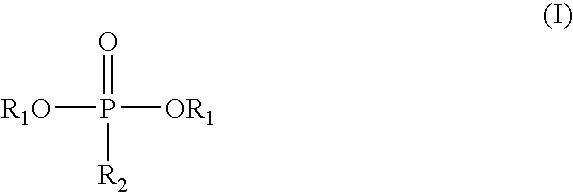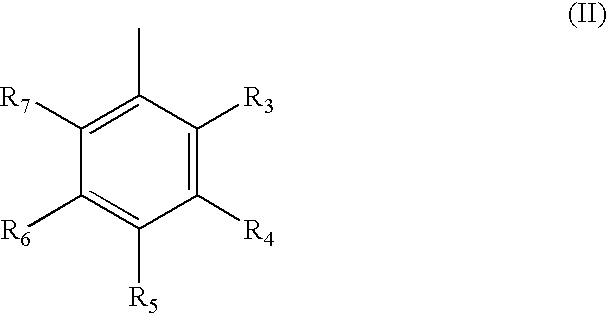Method for the production of block copolycarbonate/phosphonates and compositions therefrom
a technology of copolycarbonate and phosphonate, which is applied in the direction of organic chemistry, organic chemistry, chemical apparatus and processes, etc., can solve the problems of inability to realize the properties of this combination by combining polycarbonates and polyphosphonates, lack of flame resistance of polycarbonates, and failure to achieve flame resistan
- Summary
- Abstract
- Description
- Claims
- Application Information
AI Technical Summary
Benefits of technology
Problems solved by technology
Method used
Image
Examples
example 1
State-of-the-Art Comparative Example
Random Copolycarbonate / Phosphonates
[0073]This state-of-the-art comparative example was prepared following the procedure described in U.S. Pat. No. 4,322,520.
[0074]Into a 250 mL three neck round bottom flask equipped with a distillation column and mechanical stirrer was placed 2,2-bis(4-hydroxyphenyl) propane (bisphenol A, 32.2 g, 0.167 mole), methylphosphonic acid diphenyl ester (96% purity, 4% phenol) (12.41 g, 0.048 mole), diphenylcarbonate (29.65 g, 0.139 mole) and 5 mg of sodium phenolate catalyst. The mixture was heated to 250° C. under vacuum. The temperature was gradually increased to 300° C. over a 6 hour period. As the temperature was increased the vacuum was decreased from about 200 mm to about 1.5 mm Hg. During this time 36.30 g of distillate was collected. The column was removed from the flask and the mixture heated to 300° C. under 1.5 mm Hg for 5 hours. Distillate (1.9 g) was also collected during this step. The yellow solid (38.62 g...
example 2
Synthesis of a Block Copolycarbonate / Phosphonate
[0076]Into a 250 mL three neck round bottom flask equipped with a distillation column and mechanical stirrer was placed the 2,2-bis(4-hydroxyphenyl)propane (bisphenol A, 53.70 g, 0.236 mole) diphenylcarbonate (33.70 g, 0.158 mole) and 8 mg of sodium phenolate (NaOPh) catalyst. The mixture was heated to 250° C. under vacuum (150-200 mm Hg) for about 1.5 hours. The mixture was subsequently allowed to cool and methylphosphonic acid diphenyl ester (23.4 g, 0.094 mole) and 12 mg of tetraphenylphosphonium phenolate (TPPOP) catalyst which is a chemical complex of tetraphenylphosphonium phenolate and phenol consisting of about 70% and about 30% of each, respectively (m.p. 145° C.) were added. The mixture was heated from 250 to 300° C. while reducing the pressure from 150 to 1.5 mm Hg over about a 4.5 to 5 hour period. A noticeable, rapid increase in solution viscosity of the melt was observed over the last hour of the reaction.
[0077]Approximat...
example 3
Synthesis of a Block Copolycarbonate / Phosphonate
[0079]Into a 250 mL three neck round bottom flask equipped with a distillation column and mechanical stirrer was placed the 2,2-bis(4-hydroxyphenyl)propane (bisphenol A, 53.70 g, 0.236 mole) diphenylcarbonate (33.70 g, 0.158 mole) and 12 mg of tetraphenylphosphonium phenolate (TPPOP) catalyst. The mixture was heated to 250° C. under vacuum (150-200 mm Hg) for about 1.5 hours. Approximately 20 g of distillate was collected during this step. The mixture was subsequently allowed to cool and methylphosphonic acid diphenyl ester (23.4 g, 0.094 mole) and 12 mg of TPPOP catalyst which is a chemical complex of tetraphenylphosphonium phenolate and phenol consisting of about 70% and about 30% of each, respectively (m.p. 145° C.) were added. The mixture was heated from 250 to 300° C. while reducing the pressure from 150 to 1.5 mm Hg over about a 5 to 5.5 hour period. Approximately 28 g of distillate was collected during this step.
[0080]The distil...
PUM
| Property | Measurement | Unit |
|---|---|---|
| temperature | aaaaa | aaaaa |
| molar ratio | aaaaa | aaaaa |
| temperature | aaaaa | aaaaa |
Abstract
Description
Claims
Application Information
 Login to View More
Login to View More - R&D
- Intellectual Property
- Life Sciences
- Materials
- Tech Scout
- Unparalleled Data Quality
- Higher Quality Content
- 60% Fewer Hallucinations
Browse by: Latest US Patents, China's latest patents, Technical Efficacy Thesaurus, Application Domain, Technology Topic, Popular Technical Reports.
© 2025 PatSnap. All rights reserved.Legal|Privacy policy|Modern Slavery Act Transparency Statement|Sitemap|About US| Contact US: help@patsnap.com



